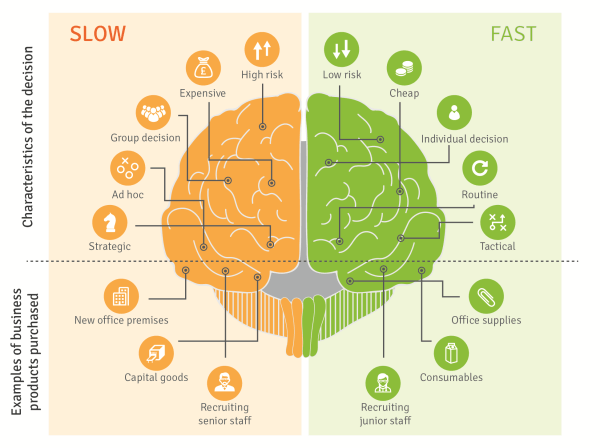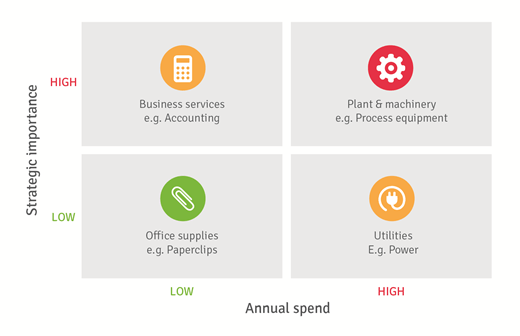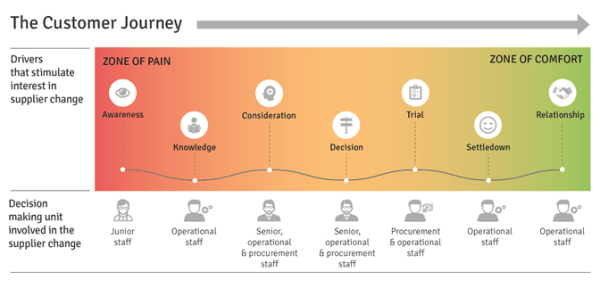Two questions are at the heart of business to business marketing – how do people make choices in favour of one supplier rather than another, and how can we push aside an incumbent supplier and break into a new account. This paper addresses these two questions and relates it to the customer journey.
How do people choose a supplier of business products or services?
The effect of fast and slow thinking on supplier choice
A Nobel prize was awarded to Daniel Kahneman, the psychologist who argued that we make decision in two ways. The first he called system 1 thinking. This is fast, emotional, instinctive and subconscious. The second he called system 2 thinking. This is slower, more calculating and apparently more logical. Much of our decision making is system 1. It is automatic. We make hundreds of small decisions every day, many of them routine and we are in auto-pilot when they happen. Our interest in this paper is the decision making that takes place in businesses, particularly those decisions involving the choice of suppliers of products and services. You would imagine these business decisions are mainly system 2. But, are they?
System 1 and system 2 thinking is different. One is fast and the other is slow. However, the speed of the decision making may be the only difference. For example, if we are in the jungle and confronted by a tiger, we wouldn’t open a spreadsheet and consider our options. We would act quickly and instinctively. Our brain would be in overdrive, processing all that we know about such situations. What we appear to do intuitively may indeed be based on everything we know and hold in our brains on this subject. Our actions may not appear to be well considered because they are taken so fast, but this is because there is no time for deliberation. It is possible that fast thinking applies the same processes as slow thinking, it is just that it doesn’t involve agonising for hours.
This slow and fast thinking affects business to business decision-making. Occasionally there are tigers in the business jungle in the sense that we sometimes are confronted by situations that need an immediate decision. However, most business decisions are not made in a panic. There is a customer journey that begins with an unfolding awareness and knowledge of a supplier. That is not to say that all business decisions are made in the same way along this journey. We can recognise fast and slow thinking at different points and it does appear to be used in different situations and with different types of products or services.
Fast & Slow Thinking In Business Decisions

This seems to make sense. Small purchases, those that are low risk and relatively inconsequential within a business, are made quickly and easily. The customer journey is short. Something which is expensive and critical to the future of the business has a much longer journey. This fits with other paradigms about decision-making in businesses. If we map the annual spend on certain products against their strategic importance to a company, the results are as follows:
Decision-Making According To Spend and Strategic Importance

This discussion leads us to believe that there is no single or simple way that decisions are made in business. However, we can identify some themes. Where there is a high level of spend and where the products are of great strategic importance, it is likely that the customer journey will be much longer than choosing a brand of paperclips.
The importance of “brand” in influencing supplier choice
This is not to suggest that logic is more important when buying a new production line compared to paperclips. It could be argued that the more difficult the decision (and this would imply an expensive product) the stronger will be the emotional influence. Complex decisions are likely to involve a considerable amount of detail, so much so they become difficult to process. When decisions are unduly complex, the brand becomes a crutch we lean on. It synthesises everything we know about a product or company and provides us with a promise we can trust. Rather than analyse every nitty gritty part of the offer, why not take it in the round? Why not simply trust a brand? Malcolm Gladwell, in his book Blink, argues that the lengthy procrastination that often takes place in decision-making is a “post self-justification” because actually we make our mind up in a blink. Brands help us do this.
Brands are important in most business to business decisions. They are enablers that help us decide which suppliers should be considered at every stage of the journey. In the first instance they enable us to quickly decide which suppliers should be in our “consideration set”. As we move through the journey and get into detail and compare the pros and cons of the supplier we will undoubtedly wear tinted spectacles, the degree of hue influenced by our perceptions of the brands. And finally, when everything has been scoped, and we need to choose between two suppliers who look very similar (this is often the case), the brand kicks in yet again. It guides us towards what we know, what we trust and that which we marginally prefer. This tells us that emotions are an important part of the decision making process and they are enacted through brands. Brands play a role at the beginning, middle and the end of the decision-making process.
The Role Of Brands In The Decision Making Part Of The Customer Journey
Stage 1: Which suppliers to consider?
The mother brand influences the small assemblage of companies in the consideration set.
Stage 2: Comparison of features and benefits
Rational thinking and logic begin to play an important role as the decision makers consider the pros and cons of the suppliers in the consideration set. Brands influence the perceptions on all attributes that are on offer by the suppliers.
Stage 3: The final choice
When there is little to choose between suppliers in terms of their performance, their price and availability, the brand kicks in again and influences the final decision.
The importance of understanding the decision making unit
We should not assume that this decision making is the responsibility of one person. In most organizations there are a number of people who have a say and these can differ on the customer journey. Many business buying decisions are made by small committees of 2, 3 or 4 people. There is likely to be a key decision maker and this person will take the lead in the specification. For example the purchase of a new production line will inevitably involve the head of production. There will be additional influences from the technical team, procurement staff and members of The Board. You can imagine how complicated and protracted such decisions can be. The personalities of the individuals have just as much influence as their functional roles. Again we can reasonably postulate that the more important the decision, the more senior will be the decision-making team and the longer the procrastination.
How can we push aside an incumbent supplier and break into a new account?
In the above discussion we have assumed that a company is looking for a new supplier and is proactive in their search. Now we turn to occasions where a supplier takes the initiative and tries to persuade a company to switch in its favour.
The influence of inertia on supplier choice
We have already mentioned the bias that brands impart on decision making. People have predilections (or otherwise) for brands which are based on a host of factors. We can imagine the biases that are built up about a supplier that has been used for many years. This is usually to that supplier’s advantage. We know this because the surveys we carry out tell us that an incumbent supplier can hold on to a customer’s business for many years despite the key decision makers appearing open minded about a change. It is not unusual in a business to business interview for the conversation to go something like this:
Q. What do you look for when choosing a new supplier?
A. Quality is really important. Of course, the product must also be available and at a very competitive price.
Q. How easy or difficult would it be for you to switch suppliers?
A. We would have to do some tests of the new product but in principle, it wouldn’t be too difficult.
Q. How often have you changed or introduced a new supplier in the last five years?
A. We haven’t.
It is astonishing that companies claim to choose suppliers on the basis of logical comparisons of price, quality and availability, and yet they seldom switch. This is despite a wide choice of other companies capable of offering cheaper products, better products or better availability.
Two factors could be at play here. Firstly businesses are risk averse. Once a supplier is well installed with a company and it has moved on through the customer journey, it enters the zone of comfort. This tallies with one of Daniel Kahneman’s findings which states that people are more worried about a decision creating a loss rather than a gain. A new supplier is a gamble. Promises made by the would-be supplier may come to naught. The incumbent brand is known and trusted. At least it is the devil that is known. The new brand, at this stage, is simply a promise.
Secondly, businesses don’t like unnecessary effort. Changing suppliers requires effort as well as possible risks. Why make a change and go to lots of effort when the chances are the new supplier will regress to the norm; in the end being little different to the incumbent? The incumbent supplier is protected by the comfortable position it occupies and can be ousted only with difficulty or if they do something wrong and create a zone of pain.
Conclusion – understanding decision making and the customer journey
Winning new business requires us to understand where the customer sits in the life-cycle with the supplier. We must also understand what is driving the potential supplier change. At the beginning of the customer journey a junior member of staff may be charged with finding out a number of suppliers that could be of interest. As we have discussed earlier in this paper, many companies are very comfortable with their existing suppliers and will only seriously consider a change if there is a pain point – for example, poor delivery, poor quality, a difficult relationship and the like.
Prompted by moments of truth that cause pain with their current suppliers, there is an appetite for a customer to change. As knowledge is acquired on the potential suppliers, different people at the customer become involved. Certainly operational people such as those on the production line or in technical functions will want to be assured that the new supplier has products and services that will fit. The procurement staff will undoubtedly want to check on prices.
B2B Decision Making And The Customer Journey

Eventually a decision to use a new supplier will (hopefully) be made and trial orders will be placed. After a settling down period we can anticipate that a strong and comfortable relationship will be developed which will give the new supplier a high level of security as long as they keep delivering pleasure rather than pain. This understanding of the life-cycle and customer journey is at the heart of how businesses buy and it is the key for business to business marketers.
Readers of this white paper also viewed:
A Practical Guide to Improving Customer Satisfaction Loyalty – How To Win Devotion From Your Customers Beyond Customer Satisfaction


